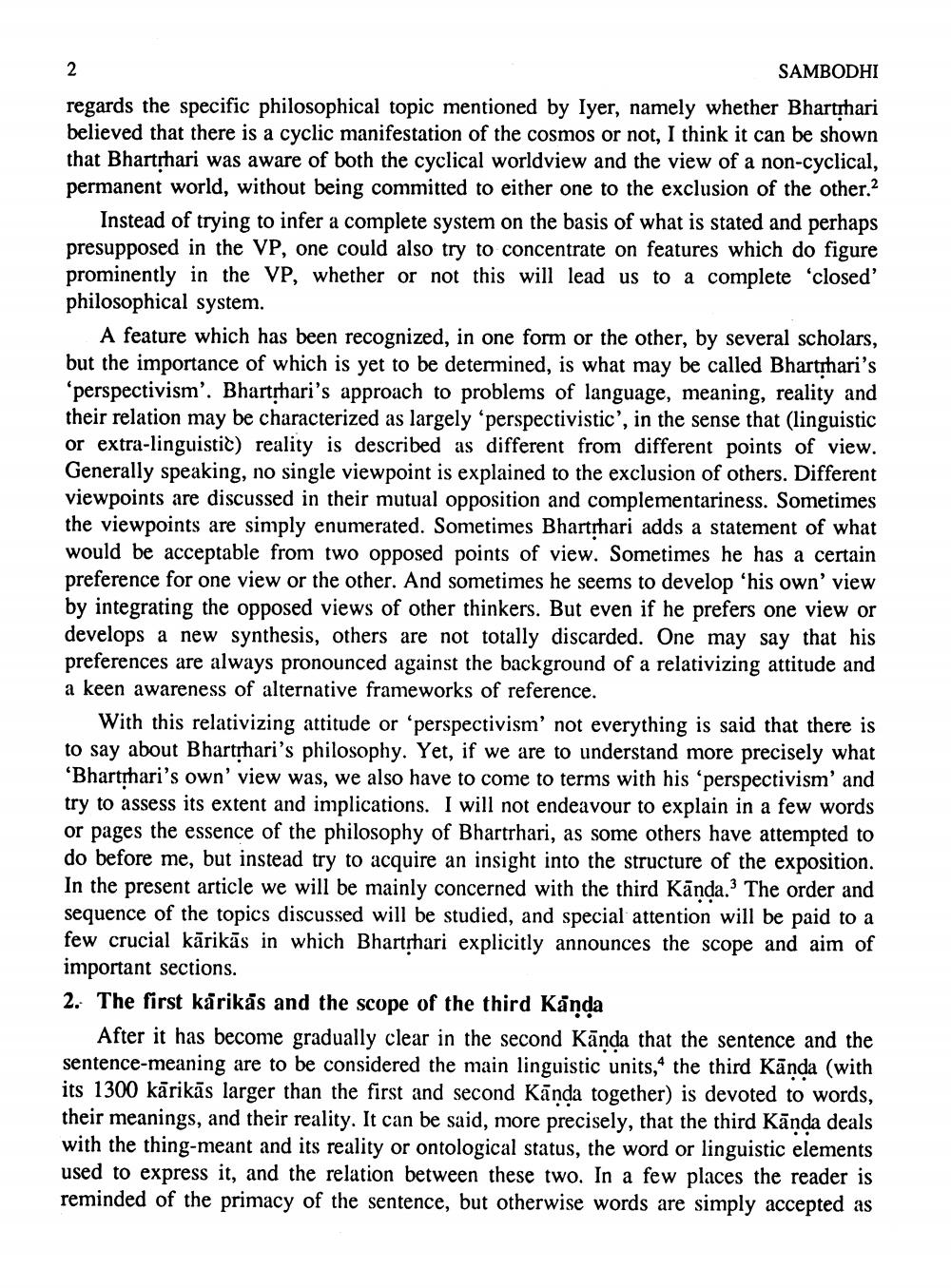Book Title: Sambodhi 1993 Vol 18 Author(s): J B Shah, N M Kansara Publisher: L D Indology Ahmedabad View full book textPage 9
________________ SAMBODHI regards the specific philosophical topic mentioned by Iyer, namely whether Bhartīhari believed that there is a cyclic manifestation of the cosmos or not, I think it can be shown that Bhartrhari was aware of both the cyclical worldview and the view of a non-cyclical, permanent world, without being committed to either one to the exclusion of the other.? Instead of trying to infer a complete system on the basis of what is stated and perhaps presupposed in the VP, one could also try to concentrate on features which do figure prominently in the VP, whether or not this will lead us to a complete 'closed' philosophical system. A feature which has been recognized, in one form or the other, by several scholars, but the importance of which is yet to be determined, is what may be called Bharthari's ‘perspectivism'. Bharthari's approach to problems of language, meaning, reality and their relation may be characterized as largely 'perspectivistic', in the sense that (linguistic or extra-linguistic) reality is described as different from different points of view. Generally speaking, no single viewpoint is explained to the exclusion of others. Different viewpoints are discussed in their mutual opposition and complementariness. Sometimes the viewpoints are simply enumerated. Sometimes Bhartrhari adds a statement of what would be acceptable from two opposed points of view. Sometimes he has a certain preference for one view or the other. And sometimes he seems to develop ‘his own' view by integrating the opposed views of other thinkers. But even if he prefers one view or develops a new synthesis, others are not totally discarded. One may say that his preferences are always pronounced against the background of a relativizing attitude and a keen awareness of alternative frameworks of reference. With this relativizing attitude or 'perspectivism' not everything is said that there is to say about Bharthari's philosophy. Yet, if we are to understand more precisely what 'Bharthari's own' view was, we also have to come to terms with his perspectivism' and try to assess its extent and implications. I will not endeavour to explain in a few words or pages the essence of the philosophy of Bhartrhari, as some others have attempted to do before me, but instead try to acquire an insight into the structure of the exposition. In the present article we will be mainly concerned with the third Kānda.? The order and sequence of the topics discussed will be studied, and special attention will be paid to a few crucial kārikās in which Bhartrhari explicitly announces the scope and aim of important sections. 2. The first kärikäs and the scope of the third Kanda After it has become gradually clear in the second Kānda that the sentence and the sentence-meaning are to be considered the main linguistic units, the third Kānda (with its 1300 karikās larger than the first and second Kānda together) is devoted to words, their meanings, and their reality. It can be said, more precisely, that the third Kānda deals ith the thing-meant and its reality or ontological status, the word or linguistic elements used to express it, and the relation between these two. In a few places the reader is reminded of the primacy of the sentence, but otherwise words are simply accepted asPage Navigation
1 ... 7 8 9 10 11 12 13 14 15 16 17 18 19 20 21 22 23 24 25 26 27 28 29 30 31 32 33 34 35 36 37 38 39 40 41 42 43 44 45 46 47 48 49 50 51 52 53 54 55 56 57 58 59 60 61 62 63 64 65 66 67 68 69 70 71 72 73 74 75 76 77 78 79 80 81 82 83 84 85 86 87 88 89 90 91 92 ... 172
